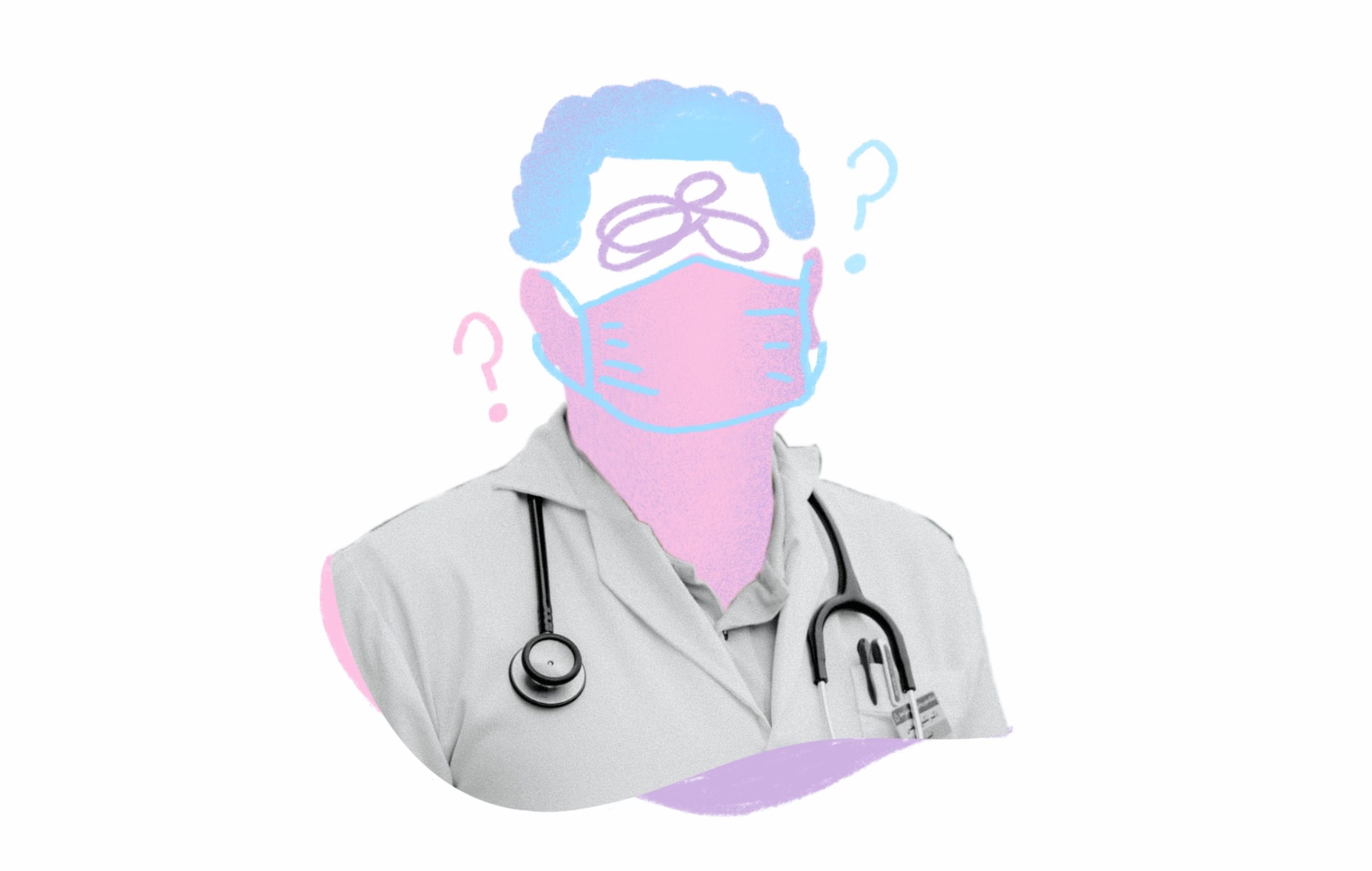With their wellness in the hands of an incompatible medical system, trans students have to be their own experts
By Jay Ashdown
After calling four walk-in clinics to no avail, Aisha Sharma sat in the first medical centre to tell her “yes” over the phone. She was visiting her family in Edmonton last December during her third year attending the RTA media production program at Toronto Metropolitan University (TMU). As a transgender woman on hormone replacement therapy (HRT), she’d come to rely on the nurse at the university’s Medical Centre to give her a weekly estradiol injection.
Across the room, the doctor picked up Sharma’s vial of medicine and furrowed his brow at the label. “This is estra-estra-dee-ahl? What is this for—gender therapy?”
“He starts typing on his computer and asks me some random questions, like, ‘any allergies, anything like that,’” Sharma recalls. After a minutes-long slew of questions, silent Google searches and awkward pauses, the doctor tells her he can’t do the procedure. The shot was due and the medication—which Sharma brought from home—was right there. But the one barrier in the way was Sharma’s trans identity.
“I literally was on the verge of tears.”
For years, access to HRT has proven to be essential for many trans patients’ wellbeing, improving mental health conditions and reducing the risk of suicide across the community, according to research from the Trevor Project. Gender-affirming care can be life-saving but with common experiences like Sharma’s as just one example, many of Canada’s healthcare services don’t convey a sense of urgency.
As prescription medications, most hormone therapies are funded by the Ontario Health Insurance Plan (OHIP)+ and partially covered by the Toronto Metropolitan Students’ Union’s (TMSU) insurance plan. As of Fall 2024, TMU’s Medical Centre offers access to in-house specialists who can provide HRT and top or bottom surgery referrals. But those who are graduating or live far from Toronto lose access to campus clinic services, leaving them to navigate Canada’s public health system on their own.
For trans students in need of timely, accessible and respectful treatment, transphobia is an invisible hurdle adding to the system’s labyrinth of forms, clinics and unreliable doctors. Under provincial medical services already suffering detrimental budget cuts and staff shortages country-wide, these problems are exacerbated for patients seeking out gender-affirming treatments.
Not only are practitioners often unavailable, many still don’t know how to treat trans people—or just don’t want to—according to research by the Ontario HIV Treatment Network. Most trans Canadians have a primary doctor, TransPULSE Canada reports, but just 26 per cent have received all the gender-affirming medical care they need.
To access essential care—in lieu of guidance from provincial healthcare resources—patients have to be their own advocates in the doctor’s office.

“I generally dread going to the doctor or any healthcare [clinic] in every aspect and obviously, the trans aspect,” says fourth-year RTA media production student Aveen Damghani. Being non-binary and trans, their time spent with their family doctor and therapist has been fraught with invalidation. Damghani now keeps their appointments as short as possible.
“I let them know once and they’re confused and then I let them know again,” they recall. “When we call sometimes, [my psychiatrist] is like, ‘what were your pronouns? He? She? They? What are you right now?”
For Kay*, a professional music student at TMU, ignorance is a frequent lowlight of her routine clinic visits. When picking up her HRT prescriptions, she typically has to explain her identity to pharmacists the first time they see her legal name on her medical file. “Obviously, I don’t care what the person giving my meds thinks of me,” she says. “It’s more about me having to broadcast that that’s my [deadname].”
On one of her first prescription pick-ups, Kay found out her name change had complicated her order in the OHIP filing system. Without knowledge surrounding trans procedures, the pharmacist couldn’t figure out how to input the correct one. “They started asking me how to do it,” recalls Kay. “I was like, ‘I don’t know, I don’t work here!”
“I generally dread going to the doctor or any healthcare [clinic] in every aspect and obviously, the trans aspect”
When ignorant doctors become a barrier to basic medical services, patients have to plan around their clinics’ incompetencies before booking appointments. In many cases, because of a lack of available peer-reviewed research on what can be common trans procedures, the internet is the most reliable place for real-world advice.
“Reddit is amazing for trans people,” Sharma says. While looking into potential routes for eventually getting her gender-affirming surgeries in Canada, the first-person tell-alls posted in social media communities have given Sharma more practical information than most other publicly available resources she’s come across. “Someone will be like, ‘Hey, this was my surgeon. Take a look.’”
Patient’s tips posted on online platforms have helped some folks guide their medical transition processes more so than doctors themselves. The common lack of expertise from general practitioners often means self-researching their course of gender-affirming treatment. By consulting the tried-and-true experiences of fellow patients trans folks can tailor their own treatment plans.
When stuck in this awkward rift between customer and practitioner, patients rely on advice and strategies from community members to “hack” the system.
For three years, that community support has been the operational crux of Montreal’s Trans Patients Union (TPU).
Starting within Queer McGill, the university’s 2SLGBTQ+ student advocacy network, the union has published community-informed policy recommendations for student clinics to make the HRT and surgical recommendation process more comfortable for their trans patients. Since then, TPU has expanded to serve participants—students and non-students—throughout Montreal, covering the needs healthcare institutions often don’t consider.
One of the union’s newer services is their appointment accompaniments, during which an organizer will come along with a patient to their clinic visits. This way, a union representative can catch and confront medical transphobia as it happens, or “Karen out,” as TPU organizer Silas Dixon has lovingly named it. Patients can come to the union’s experienced coordinators and detailed online resource lists to figure out where and how they can reach transition care in the first place. With little available information on each local doctors’ standard of care toward 2SLGBTQ+ clients, the system is daunting without this peer-to-peer helping hand.
“We have a way better sense of what’s actually going on [because] we’re all trans people who are accessing healthcare in Quebec ourselves,” says Dixon from his home office, “We know the hacks. We know what’s up.”
The inaccessibility of gender-affirming gear—apparel that helps trans people feel more comfortable in their bodies without medical procedures—is also a sore spot. Neither OHIP+ nor TMSU’s plan cover gear as a medical necessity, so those who need it typically have to pay out of pocket.
“So much of the time you can’t buy it in-person and the financial burden of it is very unfair,” argues Sam DeFranco, lead coordinator of the TMSU’s Centre for Safe Sex and Sexual Violence Support (C3SVS). “It’s an extra expense just because you’re trans.”
Since re-opening the organization’s Student Campus Centre office after the COVID-19 pandemic restrictions were lifted, multiple trans students had come to DeFranco’s desk to air out their struggles finding gender-affirming gear.
After watching a student speak about their life on campus at a TMU Trans Awareness Month event, DeFranco recruited their help developing the concept of the Gender-Affirming Gear Grant. The program has been available since 2023, as a $100 reimbursement plan for students who have bought or are planning to buy affirming items like binders and gaffs. As of this year, the program carries out between 20 and 30 orders annually. Inspired by her trans friends and clients, DeFranco remains determined to expand the C3SVS’ reach to TMU’s trans community members.
“Slowly the word is getting out, and we’re increasing our numbers more and more as time goes on.”
More trans-centred initiatives have pooled their efforts and resources to address the community’s widespread need for gender-affirming healthcare support over the past decade.
“The healthcare I was receiving was very disconnected and honestly made me very uncomfortable”
This year the 519, one of Toronto’s largest 2SLGBTQ+ community centres, introduced its Gender Affirming Care Legal Support Clinic. With its educational sessions and 15-minute appointments, the program offers trans people a chance to get free, one-on-one professional legal advice and advocacy against unjust medical restrictions. Virtual resources—like Trans Wellness Ontario and TransCare+—have developed its services for years. Their aim is to guide clients through the medical transition process with dedicated access to professional advice. The organizations detailed databases of healthcare recommendations are tailored to trans clients’ priorities.
Despite the positive impacts of community-led resources, activists argue political action is still needed to improve Canadian clinics’ standard of care.
At the Queen’s Park lawn on a September afternoon in 2023, Damghani joined the swelling crowd of 2SLGBTQ+ and allied counter-protestors facing off against the “1 Million March 4 Kids” picketing group. The picketers formed protest groups in major cities across the country and assembled through social media.
As the queer and trans cohort—who had reportedly outnumbered the protestors by the early evening—held their group together, Damghani witnessed participants of the march shout threats and shove trans counter-protestors. They recount witnessing the harassment where the line of Toronto police—presumably there to prevent violent outbursts—did nothing.
“From the way the cops are facing, you can tell which ones they think are a threat or not,” they say. Watching the scene unfold in front of them, the police’s blank stares suggested to Damghani a larger pattern of inaction: government institutions do not keep trans people safe.

The country-wide Million March protests of September 2023 ran off the momentum of recent news out of Saskatchewan and New Brunswick, where province-wide restrictions on trans identification for 2SLGBTQ+ elementary and high school students were announced that summer. After the protest wave died down, Alberta Premier Danielle Smith posted an announcement on X last February unveiling her “Preserving Choice for Children and Youth” policy plans in a video. These plans include bans on gender-affirming surgeries for children and hormone therapies for those ages 15 and under.
To human rights advocates, these policy shifts were the signal of a government quickly becoming hostile to its trans citizens. Now, in the early stirrings of Canada’s 2025 federal election buzz, politicians have begun to implement transphobic language in their campaigns.
At last year’s annual “Ford Fest”, Ontario Premier Doug Ford expressed his support for “parental rights,” the movement responsible for anti-2SLGBTQ+ protests such as the 1 Million March. Early this year, Conservative Party of Canada leader Pierre Poilievre defended Alberta’s policy plans and publicly denounced the inclusion of trans women in womens’ bathrooms, change rooms and sports.
“You blink and you don’t even know that legislation has passed. You only hear about it after it’s passed,” says Damghani.“It’s like a cancer, and it suddenly spreads so fast.”
Even before the first 1 Million March, activists have become watchdogs for monitoring anti-trans policies. With the help of grassroots resources like the Anti-Trans Legislation Risk Map updated by Montreal-based advocate Celeste Trianon, community members find their own ways to keep track of cross-country legislative activity. Petitions, calls to politicians and public protests are regularly organized by 2SLGBTQ+ people and allies nationwide in order to fight injustice before more dicriminatory policy decisions unfold.
“You’ve got to actively seek out the news from your own resources,” says Damghani, “rather than wait for the news to get to you.”
After three years of working toward her degree, Sharma had enough of her RTA media production career. “I got really tired of being an artist,” she reminisces. “I got tired of telling my story, because nothing was changing.”
After years of experiences with clinics, doctors, paperwork and self-led research in pursuit of her own gender-affirming treatments, she decided she was ready to get involved in the healthcare field herself.
Despite the faults in her treatment thus far, Sharma thinks there’s hope yet for trans people to access efficient affordable care in the near future—but it’ll take a few battles with Canada’s medical institutions.
“We know the hacks. We know what’s up”
Early this year, a non-binary patient with the pseudonym K.S. took OHIP to court after she was repeatedly denied funding for her requested bottom surgery, a form of vaginoplasty that was not on the plan’s official list of insured gender-affirming treatments. Before OHIP’s final denial was overturned by the Health Services Appeal and Review Board this April, K.S. had been filing numerous insurance appeals since 2023.
Checking on her case updates in the news, Sharma was disgusted—but not surprised—by the negligence of a system meant to provide ‘free’ healthcare. “People are suing you and you’re counter-appealing them? You’ve lost,” she says, “Accept it. You are a system created for people.”
Sharma is calling for the involvement of trans people in policy decisions. “I don’t think trans people have been considered in the making of this model. It’s just ridiculous,” she says. “The healthcare I was receiving was very disconnected and honestly made me very uncomfortable.”
This September, Sharma switched directions and re-started her TMU career as a biology major, with her sights set on medical school. Though graduation is years away, she knows what she’ll do with her degree: give back to her community by working toward making gender-affirming procedures more accessible.
“I’m going to bring a few techniques that we don’t have in Canada, to Canada,” says Sharma. “I’m going to say, ‘screw OHIP.’”
By tackling the financial and clinical restrictions affecting surgeries like K.S.’s, Sharma hopes to bring trans Canadians closer to the care they need.
Now, her longtime frustration with Canada’s incompatible medical institutions can’t bring her down—instead, it propels her. Sharma says, “For me, I needed a way to help my community more directly. And that looks like having an opportunity to work with or for trans people in healthcare.”
*This source’s name has been changed for anonymity.











Leave a Reply